Adrenal Glands + Steroid hormones
1/36
There's no tags or description
Looks like no tags are added yet.
Name | Mastery | Learn | Test | Matching | Spaced |
|---|
No study sessions yet.
37 Terms
Outline the gross anatomy of the adrenal glands. (4)
1. Superior to kidneys in renal fascia and posterior to diaphragm.
2. Right gland is post. to - liver and IVC.
3. Left gland is post. to - stomach and pancreas.
4. Right is pyramidal-shaped and left is semi-lunar and slightly larger.
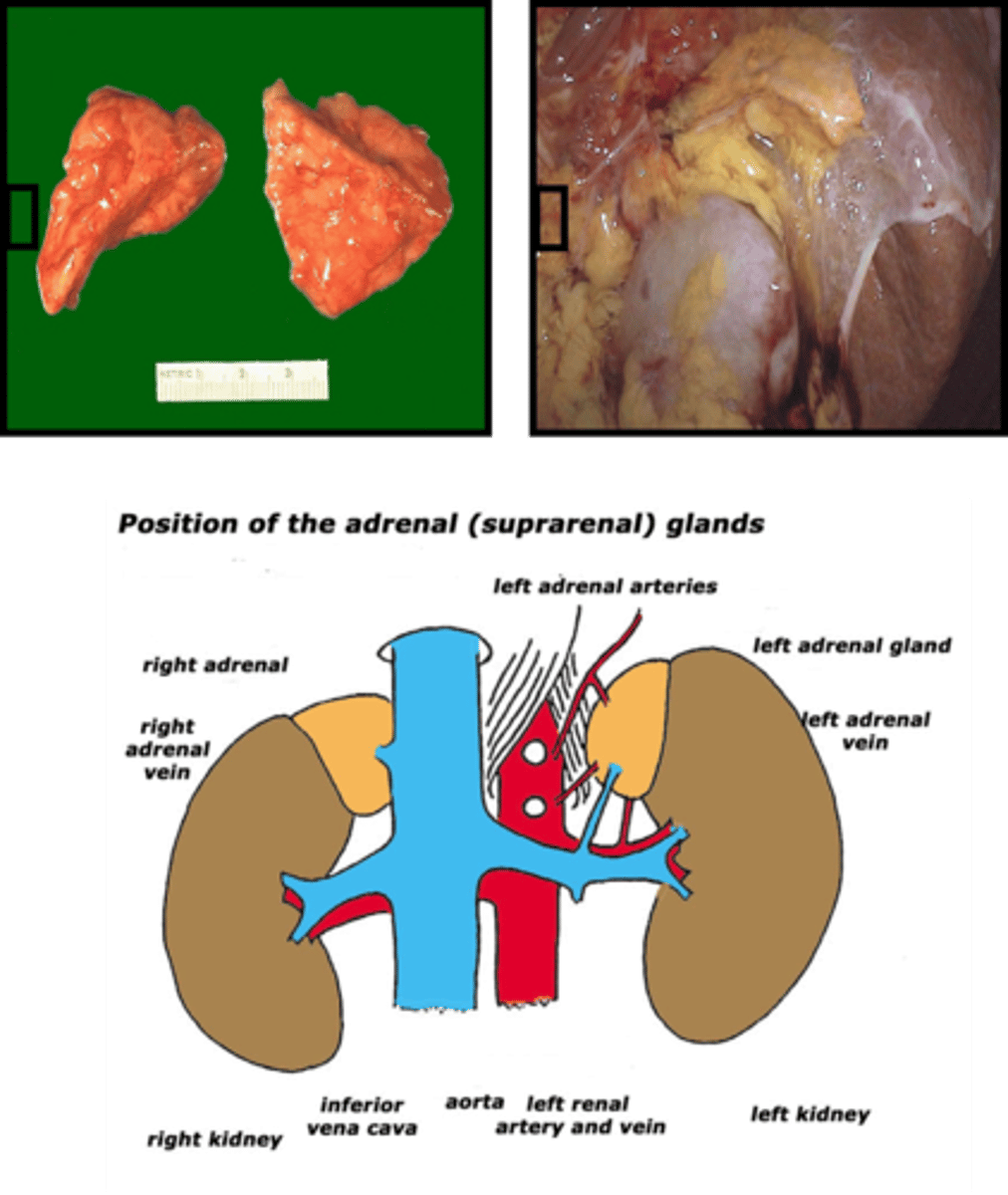
List the layers of the adrenal gland.
1. Capsule
2. Outer cortex - 3 layers
4. Inner medulla.
What does the cortex of the adrenal gland develop from + secrete
Mesoderm
secreates steroid hormones like Mineralocorticoids (e.g., aldosterone), glucocorticoids (e.g., cortisol), and weak androgens (e.g., DHEA)
What is the embryological origin of the outer cortex, what does it secrete and what controls this? (3)
1. Originates from mesoderm (like gonads).
2. Secretes steroid hormones with cholesterol precursors, controlled by pituitary.
3. Produces: mineralocorticoids (RAAS), glucocorticoids (cortisol + corticosterol) and androgenic steroids.
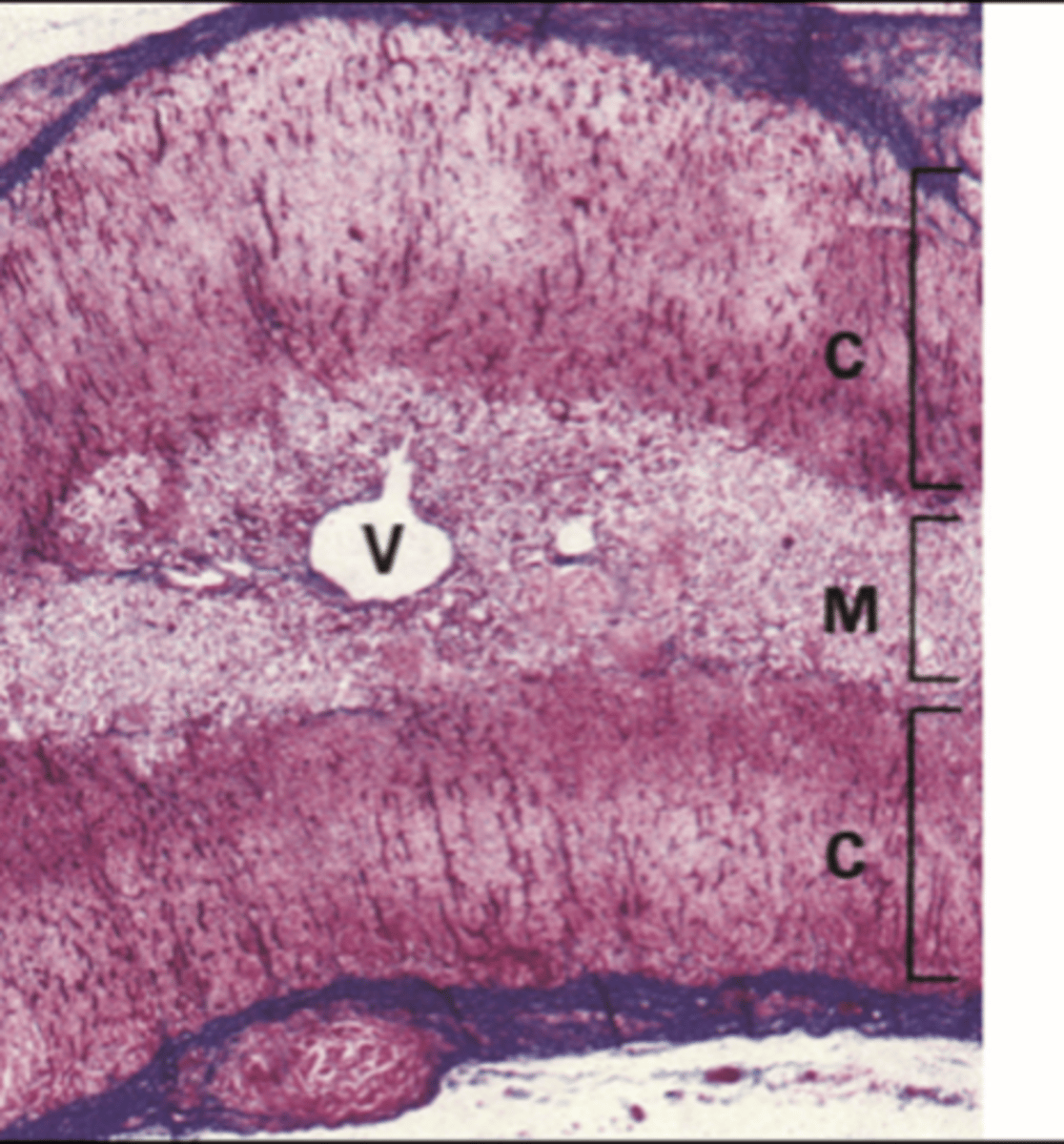
What is the embryological origin of the inner medulla, what does it secrete and what controls this? (2)
1. Originates from neuroectoderm - neural crest (like SNS).
2. Has neuroendocrine function and secretes catecholamines (A + NA), controlled by SNS.
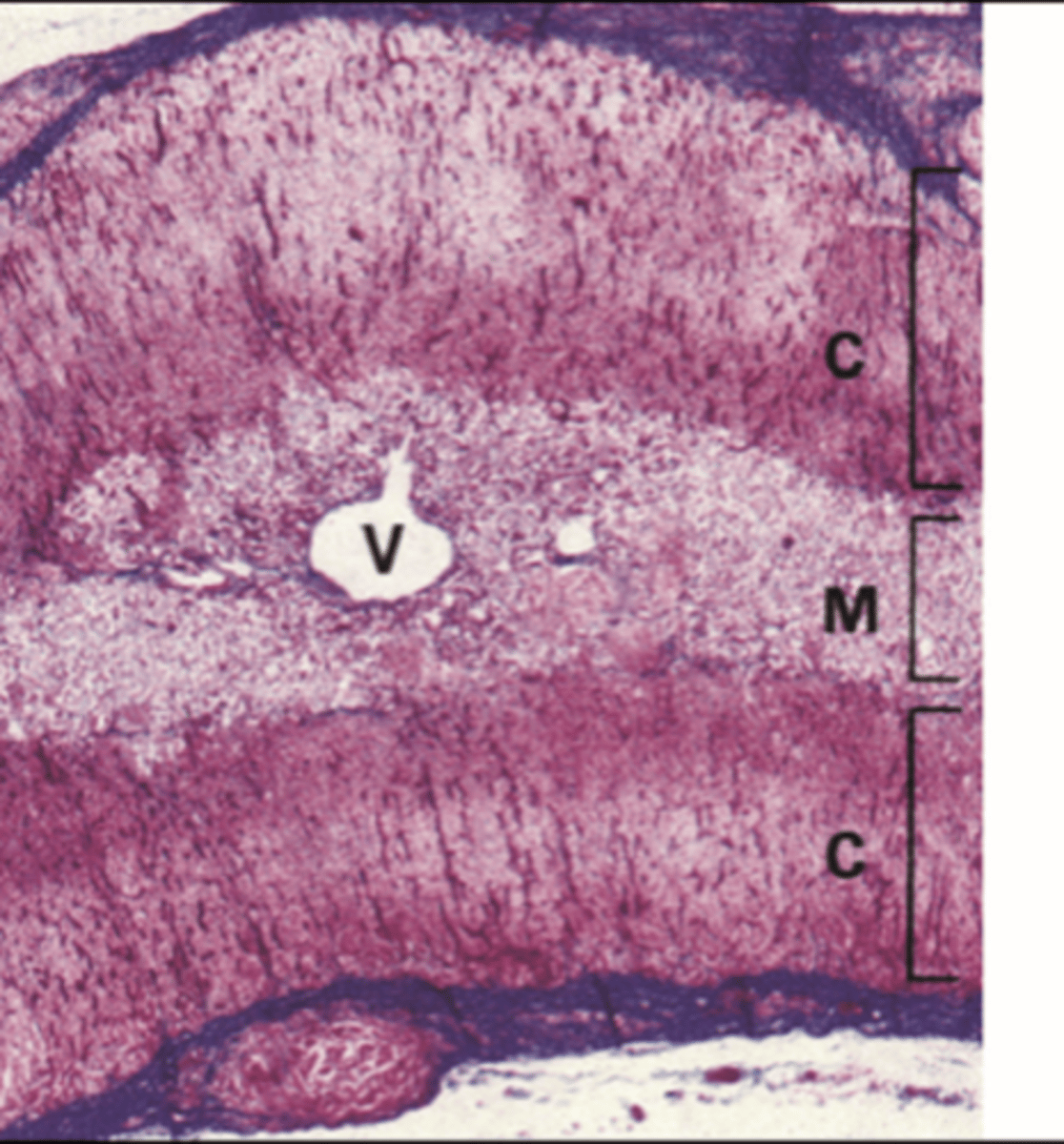
What are the zones of the cortex?
Zona glomerulosa - 'blobs' - make mineralocorticoids.
Zona fasiculata - 'strings' - make glucocorticoids.
Zona reticularis - 'network' - makes androgens.
MR Fat Guy Chris
M=medulla
C=Capsule
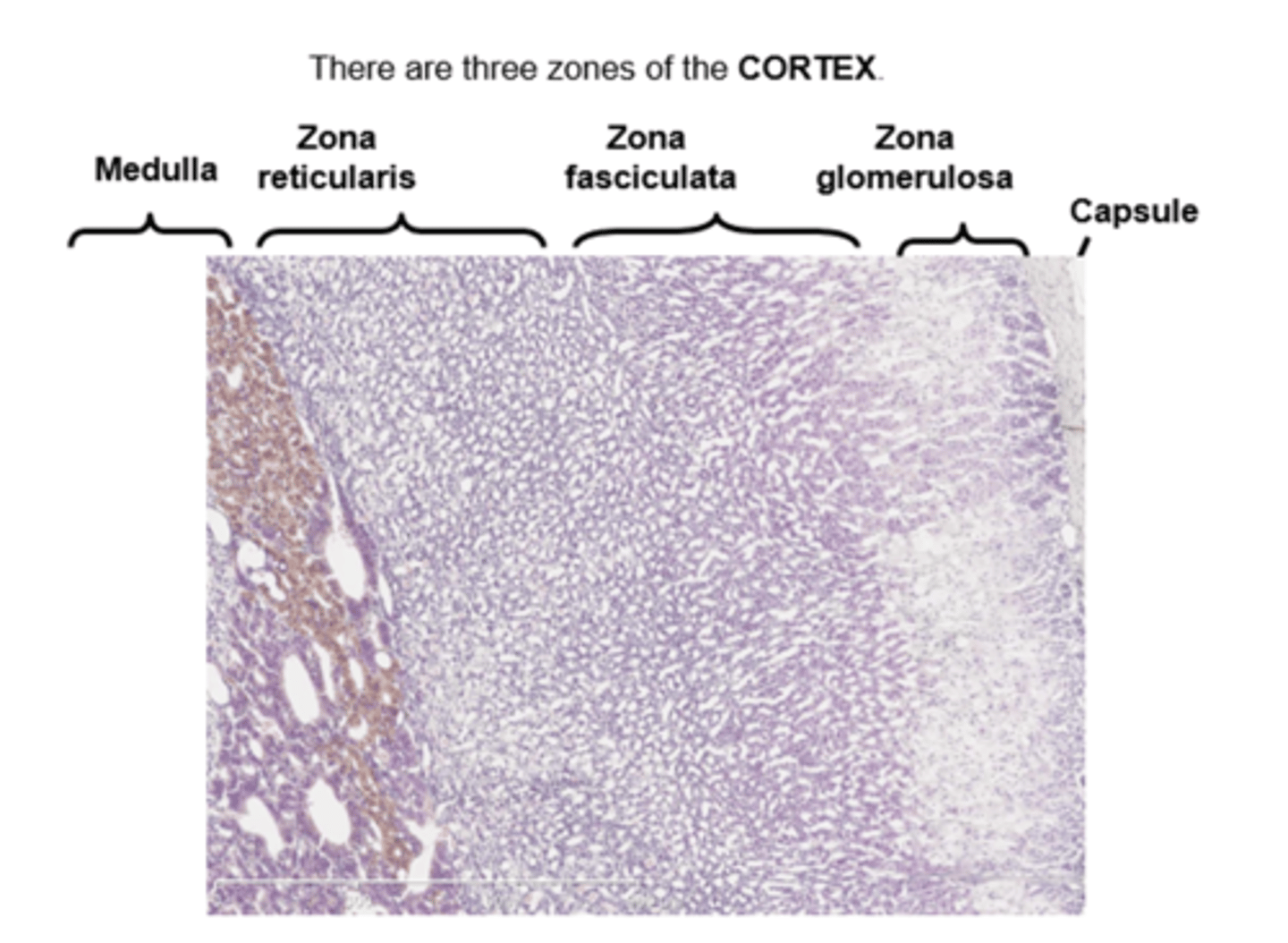
What do the cells of the cortex and medulla secreate
Cortex Cells: Steroid hormone-secreting cells.
Medulla Cells: Peptide hormone-secreting cells (catecholamines); act as a modified neural ganglion
What is the arterial supply and venous drainage of the adrenal glands?
Arteries: 3 suprarenals (superior from inf. phrenic, middle from AA and inferior from renal aa)
Veins: Right is from IVC, left is from L renal vv.
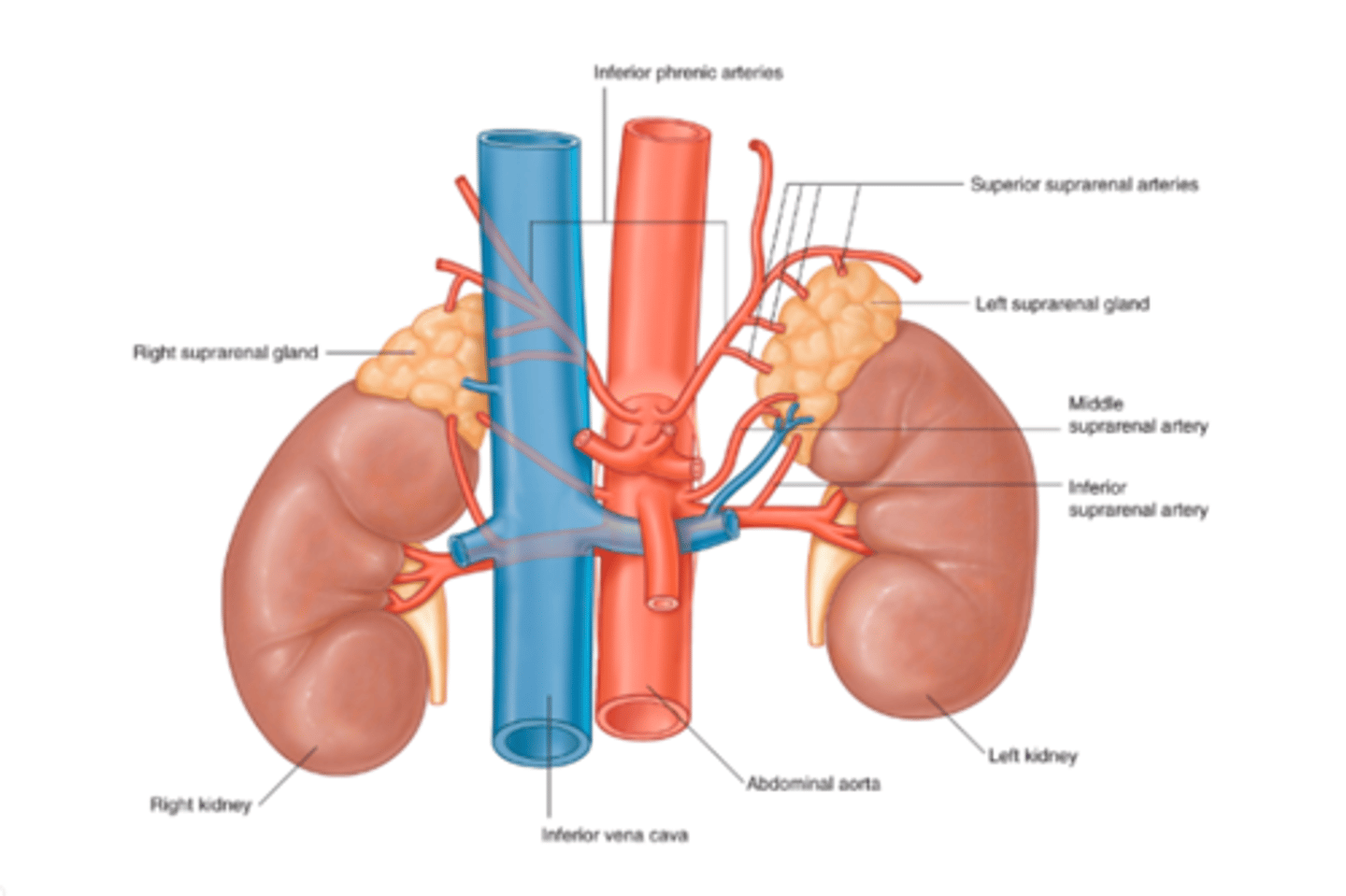
Describe the route of blood supply in the adrenal gland
Blood passes from outer cortex → inner medulla
{-Venous blood from sinusoid network}
{Arterial blood from medullary arterioles}
Gland is drained by single central vein
What are the microscopic branches of the arteries?
Suprarenal aa > arterioles > capsular aa > sinusoidal capillaries (between cells) > drain into medullary vein > suprarenal vv.
Sinusoidal capillaries have a lot of holes enabling secretion to go into blood system.

How is the adrenal medulla like a modified neural ganglion?
In normal SNS, a preganglionic fibre synapses with post. fibre and has a target cell.
In the medulla, there is a preganglionic fibre which directly targets medullary cells and stimulates them to secrete product very quickly. I.E., the secretory cell is equivalent to the post-ganglionic fibre in SNS.

What is the ultrastructure of a steroid-secreting cell from the cortex?
Has
- smooth ER
- lipid droplets and
- tubular cristae in mitochondria rather than long shelf-like cristae.
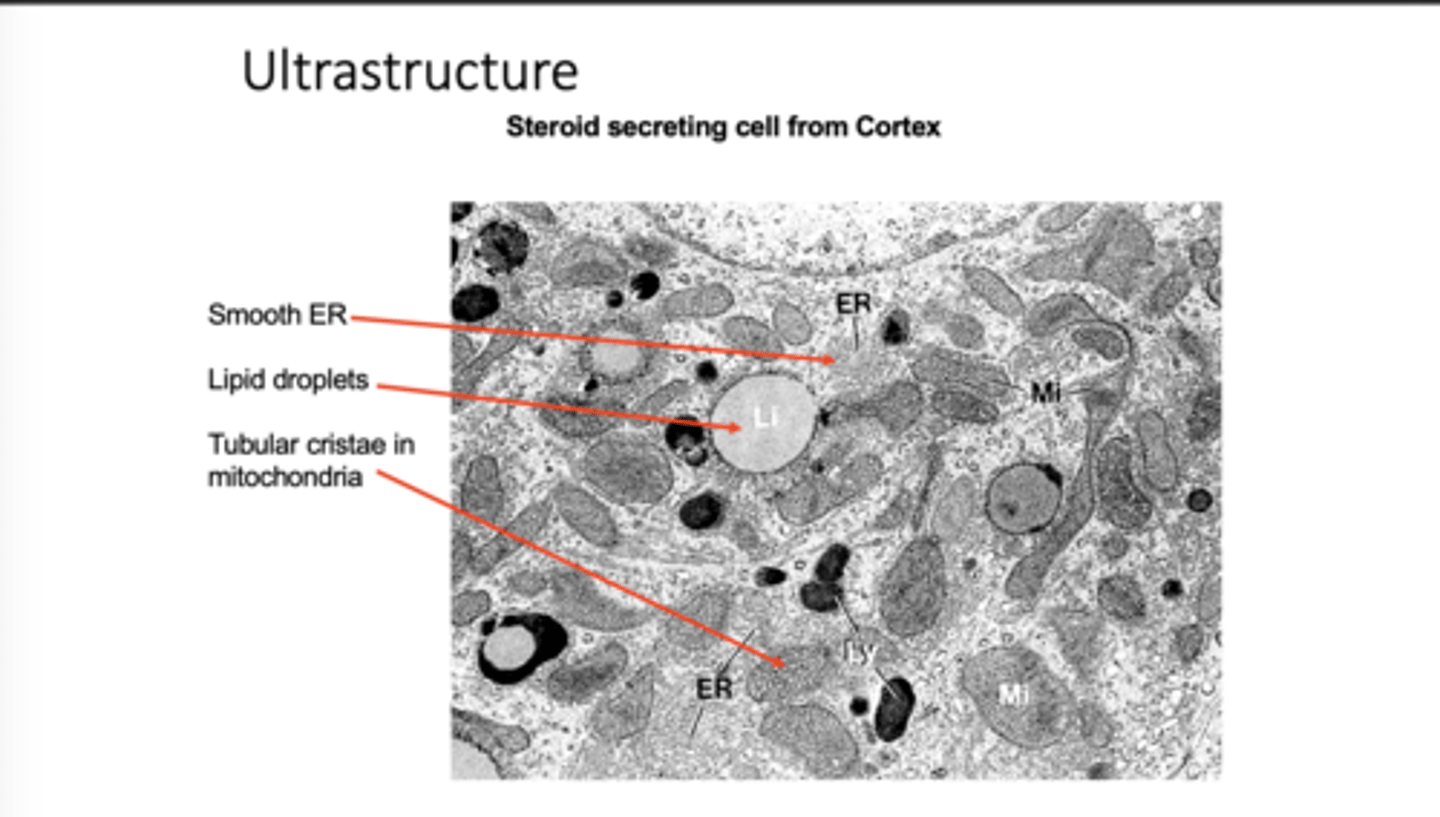
What is the ultrastructure of a peptide-secreting cell from the medulla?
Has
- rough ER and golgi
- granules (to package secretion)
- normal mitochondria
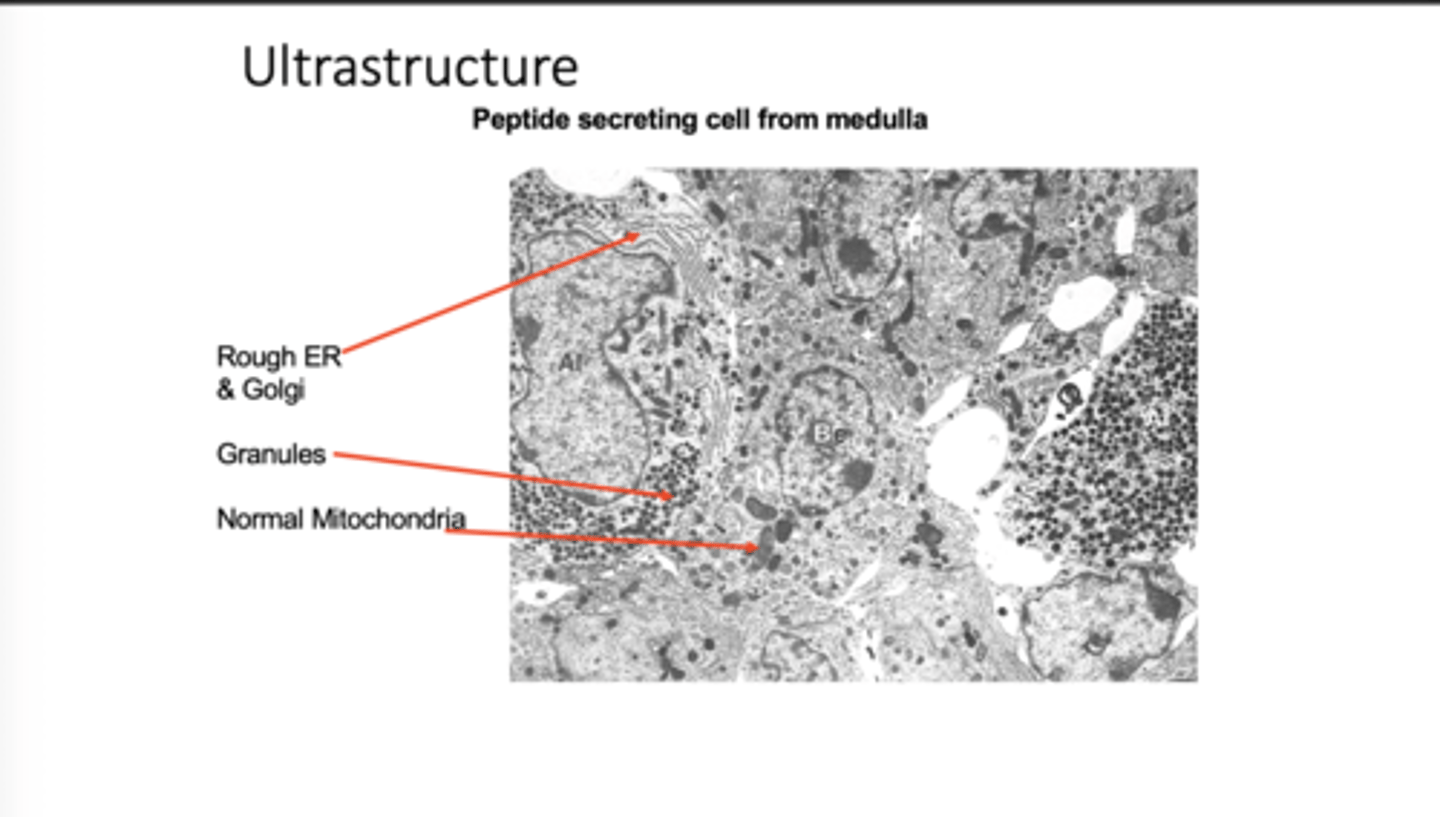
What are the pathologies of the cortex?
1. Hypoadrenalism - Addison's (no hormone secretion).
2. Hyperadrenalism (oversecretion).
Give different types of hyperadrenalism. (3)
XS mineralocorticoid: Conn's syndrome.
XS glucocorticoids: Cushing's syndrome.
Malignant tumour: All 3 in XS.
Ectopic ACTH syndrome from neuroendocrine lung tumour (small cell carcinoma): due to XS glucocorticoids.
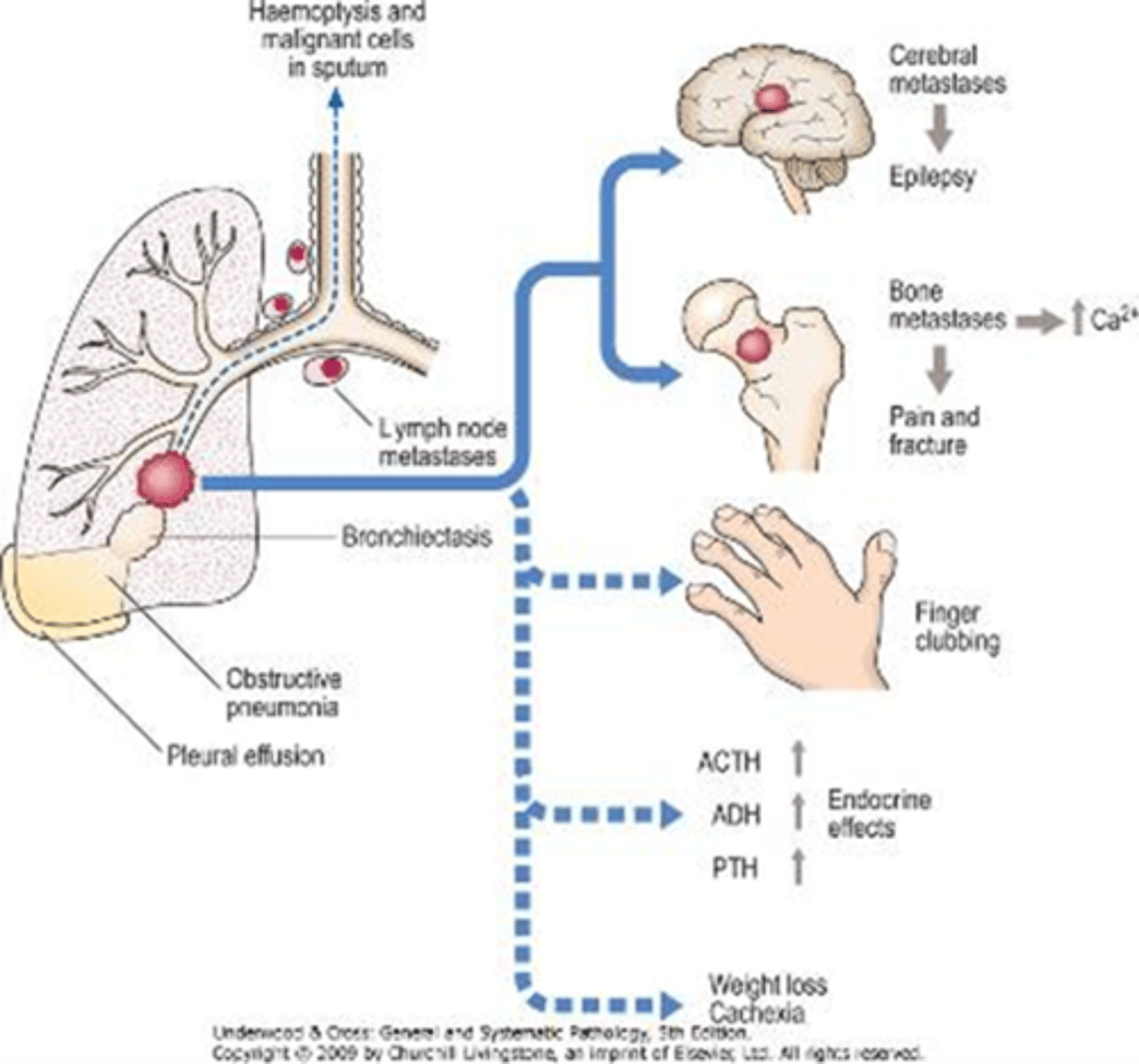
What is phaeochromocytoma i.e. causes, consequences, diagnosis? (4)
Phaeochromocytoma - pathology of medulla.
1. Rare cause of 2º hypertension due to XS catecholamines which is continuous or sporadic (50% each)
2. Mostly benign tumour of neuroectoderm.
3. Can cause lethal disease due to CV complications.
4. Diagnosed with urinary catecholamines or metabolites (not usually plasma).
What are the symptoms of phaeochromocytoma? (3)
1. Severe headache
2. XS sweating
3. Palpitations
Give a summary of the adrenal gland function.
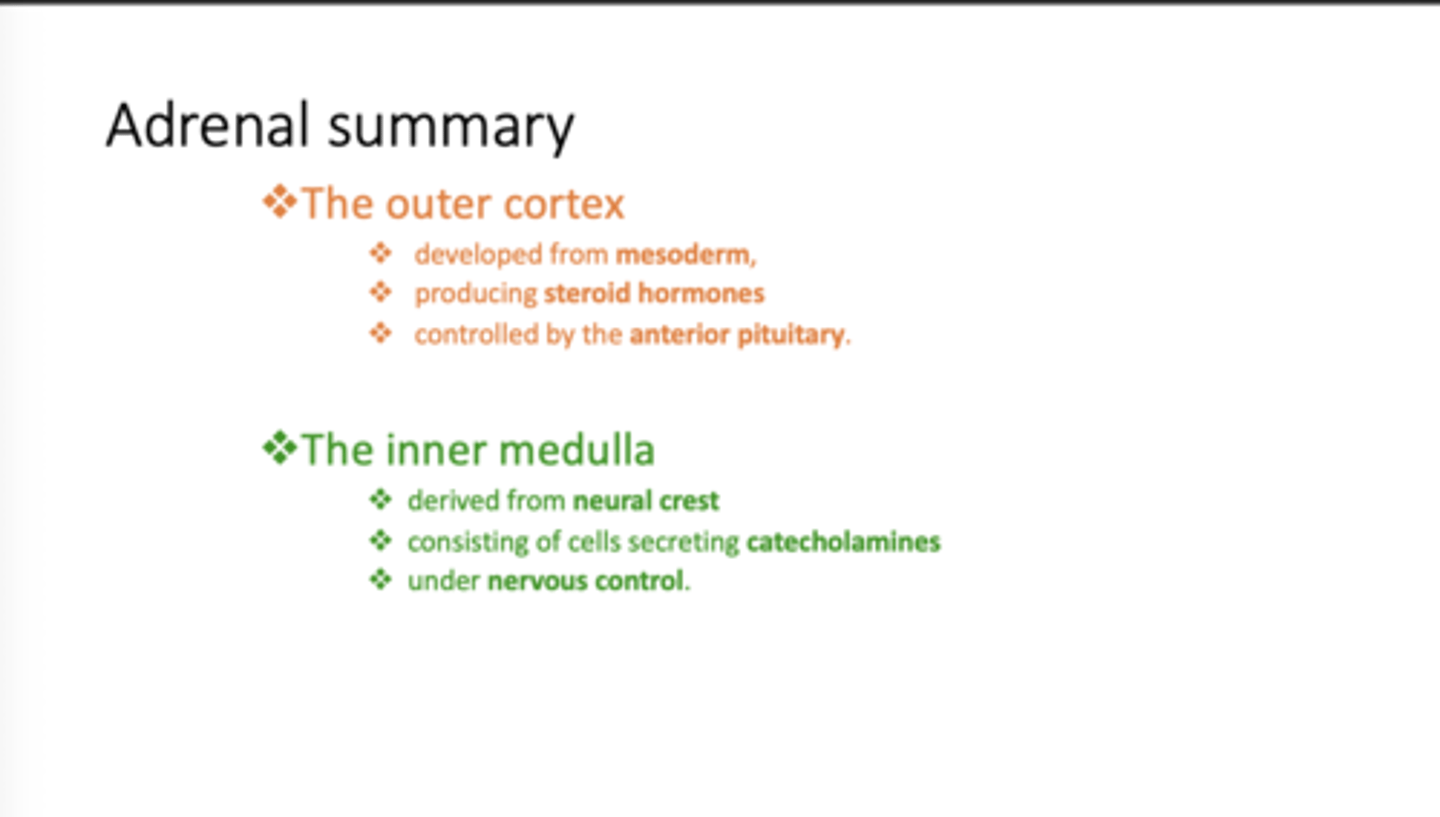

Where is cholestrol made and transported
made from = plasma LDL
It is used to transport free cholesterol from outer mitochondrial membrane —> across IMS → into mitochondrial matrix
what is the hypothalamus piturity adrenal axis regulated by
Only glucocorticoid
in the hypothalamus pituitary adrenal axis , what controls the endogenous circadian rhythms
Suprachiasmatic nucleus
What is the function of aldosterone
Promotes sodium (Na⁺) and water retention and potassium (K⁺) elimination in the kidneys (DCT and collecting ducts) during the formation of urine.
Explain how aldosterone is regulated
Stimulated by increased plasma K⁺ and the renin-angiotensin system (not significantly regulated by ACTH)
What is weak androgens
Function: In women, supports androgenic activity (e.g., pubic and axillary hair growth and libido); limited role in men.
In females = pubic hair growth, libido
in men = Negative contribution in men
Examples of Weak androgens
DHEA, DHEAS, and androstenedione
How is weak androgens regulated
Primarily controlled by ACTH
More ACTH → more weak androgens
Less ACTH → less weak androgens
but does not affect CRH/ACTH feedback loop.
What is the function of cortisol
main one fore stress response and acts as a mineralocorticoid
It is a Exogenous hormone = activates –vie feedback loop = adrenal suppression
Explain what effect cortisol have on :
Muscle
Liver
Adipose tissue
Skeletal muscle
Muscle : Catabolic effects. (breaking protein and stored Triglycer → FFA + glycerol )
Liver: Stimulates gluconeogenesis (liver) and glycogen storage, Overall elevating plasma glucose.
Adipose tissue = DECREASES GLUCOSE UPTAKE AND LIPOGENESIS and INCREASES LIPOLYSIS. The FFa and glycerol go to the liver to INCREASE GLUCOSE
Skeletal Muscle = DECREASES GLUCOSE UPTAKE via GLUT-4 , increases protein breakdowna n ddecreses protein synthesis
At high physiological levels what effect does cortisol have
Anti inflammatory and immunosupressive effects
Explain HOW cortisol does Anti inflammatory and immunosupressive effects
Stimulates production of lipocortin-1, inhibiting phospholipase A₂ (PLA2) the enzyme that makes arachodonic acid and is the precursor for prostanpids and leukotriens,→ decreases inflammatory mediators
In terms of immunity , what effect does cortisol have at very high physiological levels
Decreases number + activation of T-lymphocytes
Decreases production of cytokines
Stabilises lysosomes
Decreases nitric oxide production → NO kills bacteria + helps mediate inflammation
what are Glucocorticoid analogues
synthetic or naturally derived compounds that mimic the effects of cortisol
Act as an anti-inflammatory in:
Asthma
COPD
Skin conditons
Rheumatoid arthritis
Act as an immunosupresion in:
Organ transplantation
Act as an Replacement therapy in:
Addisons disease
Explain what happens with SNS and adrenaline in the stress response system ?
Increases cardiac output and ventilation
diverts blood to the muscle and the heart
uses glycogen and fat stores
then activates CRH-ACTH-cortisol axis
Once the CRH-ACTH-cortisol axis is activated what happens ?
shift protein and fat stores in favour of the increased glycogen store and plasma glucose availability
Amino acids become more available for tissue repair
In terms of integrated stress response:What is the action of cortisol
Promotes gluconeogenesis, lipolysis, and proteolysis, increasing blood glucose and energy availability.
Provides amino acids for tissue repair post-damage
Chronic Stress and Elevated Cortisol = Long-term elevated cortisol can lead to …..
muscle wasting
hyperglycaemia
gastrointestinal (GI) ulcers
weakened immunity (related to Cushing’s syndrome).